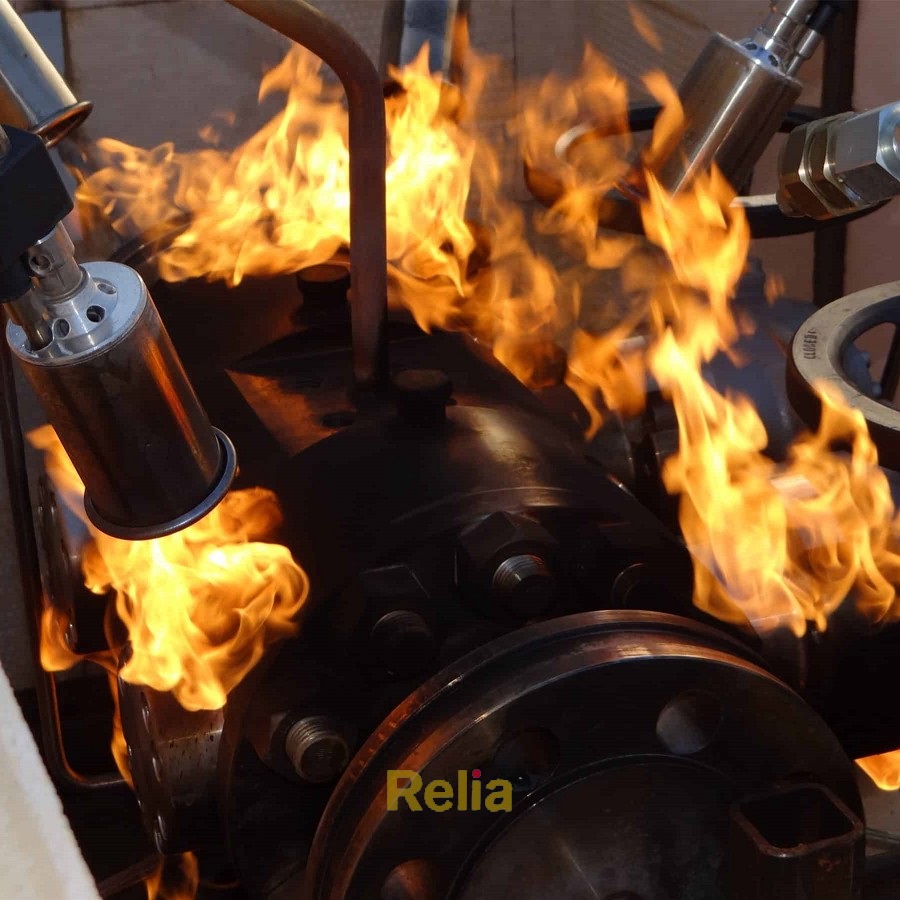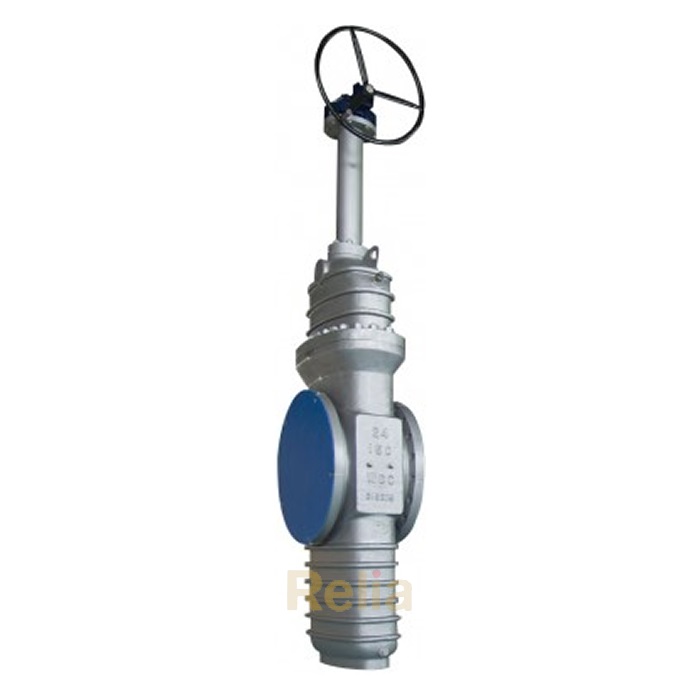ISO 10497: Testing of valves - Fire type testing requirements
ISO 10497 Standard specifies fire type-testing requirements and a fire type-test method for confirming the pressure-containing capability of a valve under pressure during and after the fire test.
ISO 10497 Standard does not cover the testing requirements for valve actuators other than manually operated gear boxes or similar mechanisms when these form part of the normal valve assembly.
Other types of valve actuators (e.g. electrical, pneumatic or hydraulic) may need special protection to operate in the environment considered in this valve test, and the fire testing of such actuators is outside the scope of this International Standard.
NOTE - For the purposes of this International Standard, the terms “fire type-test” and “fire test” are synonymous.
6 - Performance
6.1 General
Valves tested in accordance with Clause 5 shall be in accordance with 6.2 to 6.7.
6.2 Through-seat leakage during burn period
For the low pressure test, the average through-seat leakage at low test pressure during the burn period (see 5.6.11) shall not exceed the value given in Table 1.
For the high pressure test, the average through-seat leakage at high test pressure during the burn period (see 5.6.11) shall not exceed the value given in Table 1.
6.3 External leakage during burn and cool-down periods
For the low pressure test, the average external leakage, not including through-seat leakage, during the burn and cool-down periods (see 5.6.13) shall not exceed the value given in Table 1.
For the high pressure test the average external leakage, not including through-seat leakage, during the burn and cool-down periods (see 5.6.13) shall not exceed the value given in Table 1.
6.4 Low pressure test through-seat leakage after cool-down
The maximum through-seat leakage shall not exceed the value given in Table 1.
6.5 Operability
After the fire test, the valve shall be unseated from the closed position against the high test pressure and moved to the fully open position (see 5.6.15), using the operator fitted to the test valve. No additional wrenches or extensions may be used.
6.6 External leakage following operational test
The average external leakage of the valve in the open position at the high test pressure (see 5.6.16) shall not exceed the value given in Table 1.
NOTE - External leakage does not include potential leakage from the pipework-to-valve end connection (see 5.3.1).
Table 1 — Maximum leak rates
| Valve Size | Maximum leak rates (ml/min) | ||||||
| DN (mm) | NPS (Inch) | Through-seat leakage | External leakage | ||||
| During burn (see 5.6.11 and 6.2) | After cool-down (see 5.6.14 and 6.4) |
During burn and cool-down (see 5.6.13 and 6.3) |
After operational test (see 5.6.16 and 6.6) |
||||
| Low pressure test | High pressure test | Low pressure test | Low pressure test | High pressure test | High pressure test | ||
| 8 | 1/4 | 32 | 128 | 13 | 8 | 32 | 8 |
| 10 | 3/8 | 40 | 160 | 16 | 10 | 40 | 10 |
| 15 | 1/2 | 60 | 240 | 24 | 15 | 60 | 15 |
| 20 | 3/4 | 80 | 320 | 32 | 20 | 80 | 20 |
| 25 | 1 | 100 | 400 | 40 | 25 | 100 | 25 |
| 32 | 1-1/4 | 128 | 512 | 51 | 32 | 128 | 32 |
| 40 | 1-1/2 | 160 | 640 | 64 | 40 | 160 | 40 |
| 50 | 2 | 200 | 800 | 80 | 50 | 200 | 50 |
| 65 | 2-1/2 | 260 | 1040 | 104 | 65 | 260 | 65 |
| 80 | 3 | 320 | 1280 | 128 | 80 | 320 | 80 |
| 100 | 4 | 400 | 1600 | 160 | 100 | 400 | 100 |
| 125 | 5 | 500 | 2000 | 200 | 125 | 500 | 125 |
| 150 | 6 | 600 | 2400 | 240 | 150 | 600 | 150 |
| 200 | 8 | 800 | 3200 | 320 | 200 | 800 | 200 |
| >200 | >8 | 800 | 3200 | 320 | 200 | 800 | 200 |
7 - Qualification of other valves by representative size, pressure rating and materials of construction
7.1 General
Instead of testing each nominal size and nominal pressure rating of a given valve design, all valves of the same basic design as the test valve may be deemed to have been fire-tested, subject to the following limitations.
a) A test valve may be used to qualify valves larger than the test valve but not exceeding twice the nominal size of the test valve (see 7.3). A size DN 200 or NPS 8 test valve qualifies all larger sizes. If the minimum size of a given range of valves is greater than DN 200 or NPS 8, then the minimum size of the range shall be tested to qualify all sizes.
b) A DN 50 (2”) valve may be used to qualify all smaller sizes of valve of the same types. If the maximum size of a given range of valves is smaller than DN 50 or NPS 2, then the maximum size of the range shall be tested to qualify all sizes.
c) A test valve may be used to qualify valves with higher PN or Class ratings but not exceeding twice the PN or Class rating of the test valve, except as shown in Tables 3 and 4.
d) A reduced bore (or Venturi pattern) test valve may be used to qualify a smaller nominal size full bore (or regular pattern) valve when the components associated with the obturator, seat seals and stem are identical in design and size. In such a case, the permissible average leakage rates are those applicable to the full bore (or regular pattern) valve.
e) The type of valve body ends are not considered by this International Standard. However, the mass of the valve is determined in part by the body end type. For qualification to the present International Standard, and providing that all other qualification criteria have been met, valves with ends different to those of the test valve may also qualify provided that
----their mass is greater than that of the test valve, or
----their mass is not less than 75 % of that of the test valve.
7.2 Materials of construction
7.2.1 For the purposes of product compliance certification or type testing systems, the materials of construction of the pressure retaining envelope of the valve shall be deemed to qualify other materials of construction within the generic classifications below.
Ferritic
Austenitic
Duplex
7.2.2 If a range of valves is covered by testing of ferritic test valves then the type-testing coverage may be extended to cover austenitic or duplex materials by carrying out a further test on a mid-range size of valve of the same design in that material.
7.2.3 Other materials of construction of the pressure-retaining envelope of the valve require full testing of representative size and pressure ratings as specified in 7.3 and 7.4.
7.2.4 Alloy steel bolting (e.g. B7, L7) used as part of the valve's pressure-retaining envelope may be used to qualify austenitic steel bolting but not vice-versa.
7.2.5 Any change in non-metallic materials with respect to the seat-to-closure member seal, seat-to-body seal, stem seal and body joint and seal require a re-qualification. Filled PTFE, however, may qualify non-filled PTFE and vice-versa.
7.3 Qualification of valves by nominal size
The valves of other nominal sizes which may be deemed to have been fire type-tested relative to the actual valve tested are given in Tables 2 and 3.
Table 2 — Other valves qualified by DN
| Size of valve to be tested DN | Other valve sizes qualified DN |
| 50 | 50 and below; 65; 80; 100 |
| 65 | 65; 80; 100; 125 |
| 80 | 80; 100; 125; 150 |
| 100 | 100; 125; 150; 200 |
| 125 | 125; 150; 200; 250 |
| 150 | 150; 200; 250; 300 |
| 200 | 200 and larger |
Table 3 — Other valves qualified by NPS
| Size of valve to be tested NPS | Other valve sizes qualified NPS |
| 2 | 2 and below; 2-1/2; 3; 4 |
| 2-1/2 | 2-1/2; 3; 4; 5 |
| 3 | 3; 4; 5; 6 |
| 4 | 4; 5; 6; 8 |
| 5 | 5; 6; 8; 10 |
| 6 | 6; 8; 10; 12 |
| 8 | 8 and larger |
The valves of other PN and Class which may be deemed to have been fire type-tested relative to the actual valve tested are given in Tables 4 and 5.
Table 4 — Other valves qualified by PN
| Valve tested | Other valve qualified | |
| PN | PN | Class rating |
| 10 | 10; 16 | 150 |
| 16 | 16; 25 | 150 |
| 25 | 25; 40 | 150; 300 |
| 40 | 40; 63; 100 | 300; 400; 600 |
| 63 | 63; 100 | 300; 400; 600 |
| 100 | 100; 150 | 600; 800; 900 |
| 150 | 150; 260 | 900; 1500 |
| 260 | 260; 420 | 1500; 2500 |
| 420 | 420 | 2500 |
Table 5 — Other valves qualified by Class
| Valve tested | Other valve qualified | |
| Class rating | Class rating | PN |
| 150 | 150; 300 | 10; 16; 25; 40 |
| 300 | 300; 400; 600 | 40; 63; 100 |
| 400 | 400; 600; 800 | 63; 100 |
| 600 | 600; 800; 900 | 100; 150 |
| 800 | 800; 900; 1500 | 100; 150; 260 |
| 900 | 900; 1500 | 150; 260 |
| 1500 | 1500; 2500 | 260; 420 |
| 2500 | 2500 | 420 |




